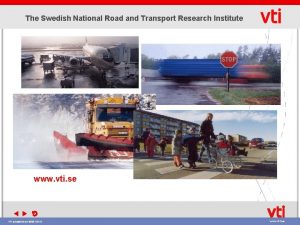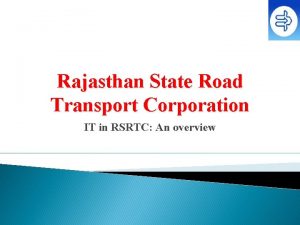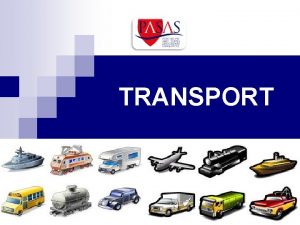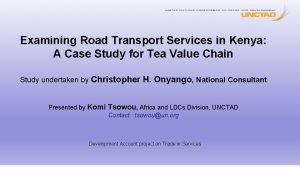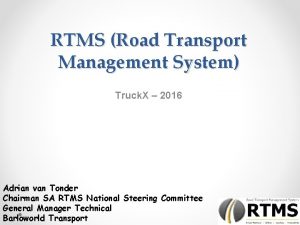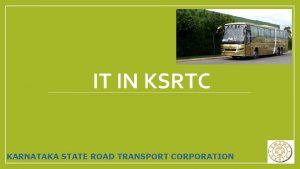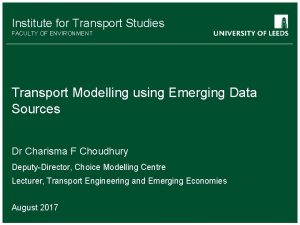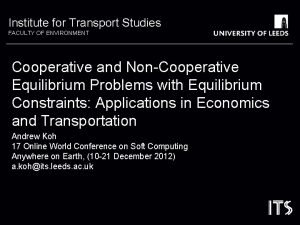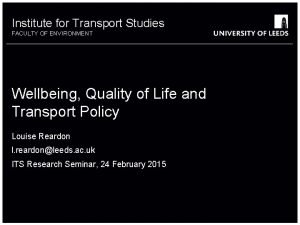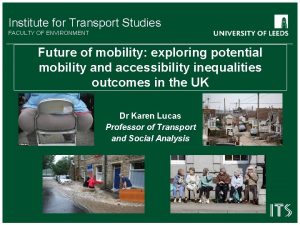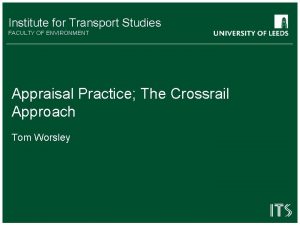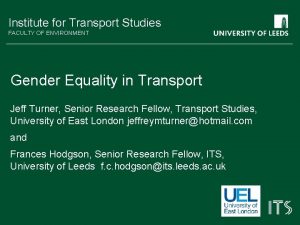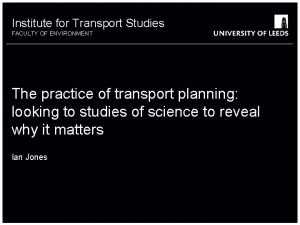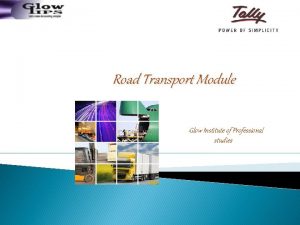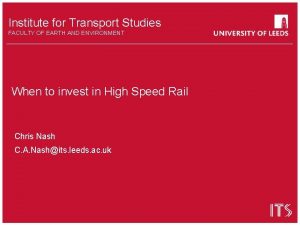Institute for Transport Studies FACULTY OF ENVIRONMENT Road















- Slides: 15

Institute for Transport Studies FACULTY OF ENVIRONMENT Road user psychology – aspects of cognition and attention that can affect road safety 15 th November 2016 Samantha Jamson (S. L. Jamson@its. leeds. ac. uk)

Intro • Psychologist @ Institute for Transport Studies (Uo. L) • Safety and human factors aspects of road user behaviour – Effects of awareness & workload on the driving task – Development and testing of systems that support driving – e. g. adaptive systems • But also more “traditional” problems such as: Drivers’ speed Young (and elderly) drivers Impairment (fatigue/alcohol) Engineering solutions (Road layout and roadside features)

The effect of emotions on performance • Many cognitive processes (visual search, decision making etc. ) are directly or indirectly affected by emotional state. • For example Isen (2001) shows that in most circumstances even mild positive emotion leads to more efficient, creative and flexible cognitive processing. • Positive emotion also enhances social skills and sympathy; they initiate and promote helping behaviours, such as donating to charity. • Negative and positive feelings are not two opposite sides on a scale - if someone is not happy, they are not automatically sad. We spend most of our time in a marginally positive state. • If we are in a negative state, then (unconscious) effort is expended to return us to this marginally positive state 3

Affect and arousal • Russell and Carroll (1999) proposed a bipolarity model which accounts not only for valence (i. e. happy versus sad) but for arousal as well. • Items on the right side refer to a happy cluster and those on the left side to a sad cluster. • Items on the top of the x axes relate to the high arousal and the items on the bottom of the x axes relate to the low arousal level. 4

What we know about emotion and driving • Research shows clear relationships between anger and self-reported near misses (Underwood, Chapman, Wright, & Crundall, 1999) as well as self-reported near misses and threatening driving • Mesken, Hagenzieker, Rothengatter, & De Ward, (2007) found that those participants who selfreported as feeling anger drove faster and exceeded speed limits more often compared to those who did not report anger 5

Anger • Anger is more likely to occur in driving situations compared to any other context. • Drivers become angry in approximately 20% of all journeys. • Anger leads to speeding • Anger was mostly associated with situations where an “other” was to blame, whilst anxiety occurred where the “situation” was to blame. • Anger is mostly associated with events affecting impeded progress, and anxiety with events affecting safety. • Most anger-invoking scenarios were those where “someone cuts in right in front of you on the motorway”. • 6 But what about positive moods…. .

. Are happy drivers safe drivers? • Three Mood conditions were induced (Happy, Neutral, Sad) • Videos containing hazards were presented • Hazard Response Time and eye fixations were measured Longest HRTs in Sad condition, shortest in Neutral 7 Those in the Sad mood fixated longer perhaps implying less switching of attention from one object to another Fixation Error?

Mood detection Technicity. Daimler. co m 8

Overview • Workload and task demand • Multi tasking • Distraction • Emotion • Task experience • Fatigue • Dual tasking – car drivers, cyclists, pedestrians all slow down 9

Multi-tasking • Physical distractions can capture the gaze (e. g. looking at a mobile phone), which means withdrawing visual attention from the road ahead, • Mental distraction (e. g. worrying about an upcoming meeting) can result in ‘looking but not seeing’. • Are some types of people better at multitasking than others? 10

Multitasking while driving (e. g. mobile phone use) Research informs us: • Hands-free phones are no safer than handheld ones. Reality out there: • Department for Transport figures show that a driver being impaired or distracted by their phone had been a contributory factor in 440 accidents in Britain last year, including 22 which were fatal and 75 classed as serious. • DVLA showed almost 240, 000 drivers had been caught driving whilst distracted at least once, with 10, 000 caught twice and 600 caught three times. • Can increase risk of being involved in a crash by 4 times. • The physical and cognitive distraction impairs visual search patterns, reaction times, decision-making processes. • Sending text message more distracting than talking on mobile • Talking on a mobile is more distracting than holding an intelligent conversation with a passenger

• Larger variations in driving speeds (particularly reductions) • Reactions to external events or objects are generally slower • Accept shorter gaps in traffic when turning 12 Kircher et al 2015 PEDESTRIANS • Greater lane position deviations and exceedences CYCLISTS What are the behavioural markers?

Is legislation is the answer? i. Younger drivers were twice as likely to enter/change destinations, 5 times as likely (for the youngest drivers) to change their music selection, and 15 times as likely to text ii. 13 Only in severe and “obvious” cases of distraction, i. e. watching a TV, did drivers’ evaluation of the distracting effects have an impact Those drivers residing in the higher legislated countries were just as likely to enter or change destinations in their PND, as those in the lowest. ii. Compared to Swedish drivers, UK drivers were half as likely to text, Italian drivers (with the strictest legislation), were just as likely to text as Swedish drivers. iii. Those in the more stringent counties were more likely to change their music selection In Italy, for example, drivers were twice as likely to change their music selection compared to Swedish, Polish and UK drivers.

Other ways to incentivise safe driving Golden rules: Shift up as soon as possible Maintain a steady speed Decelerate smoothly Anticipate traffic flow 14 • Speed reductions of 3 to 4% (free driving) • Typically a reduction of speed of 2 to 3% at specific locations • Hard braking and harsh accelerations: reduced by 5% to 10%

Thank you for listening! 15
 Swedish national road and transport research institute
Swedish national road and transport research institute Herszon kherson maritime college of merchant marine fleet
Herszon kherson maritime college of merchant marine fleet Paved road vs unpaved road
Paved road vs unpaved road Rsrtc rfid card registration
Rsrtc rfid card registration Advantage and disadvantage of road transport
Advantage and disadvantage of road transport Transport services in kenya
Transport services in kenya Road transport management system
Road transport management system Online leave management ksrtc
Online leave management ksrtc Paradigm shift from women studies to gender studies
Paradigm shift from women studies to gender studies Uniport symport antiport
Uniport symport antiport Primary active transport and secondary active transport
Primary active transport and secondary active transport Now answer the questions
Now answer the questions Passive transport vs active transport venn diagram
Passive transport vs active transport venn diagram Unlike passive transport active transport requires
Unlike passive transport active transport requires Primary active transport vs secondary active transport
Primary active transport vs secondary active transport Bioflix activity membrane transport active transport
Bioflix activity membrane transport active transport
